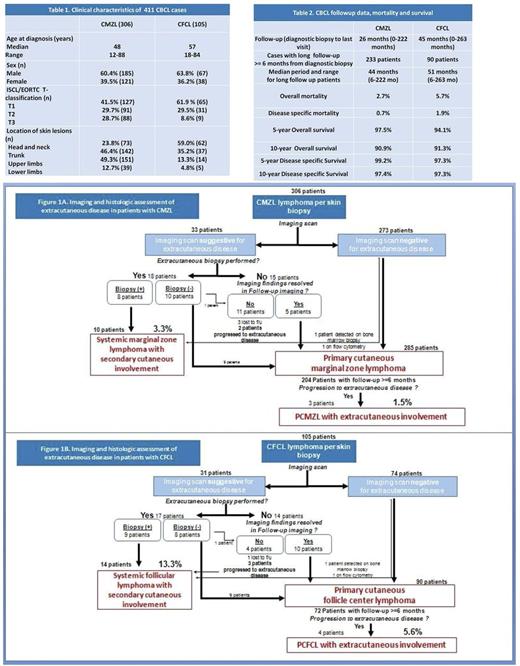Abstract
Introduction: Cutaneous marginal zone lymphoma (CMZL) and cutaneous follicle center lymphoma/systemic follicular lymphoma presenting in the skin with follicle center histology (CFCL) are low grade cutaneous B-cell lymphomas (CBCL) that present in the skin primarily or involve the skin secondarily as part of a systemic lymphoma. While primary CBCL is unlikely to progress to involve extracutaneous sites, the incidence of secondary skin involvement by a systemic BCL with initial symptoms in the skin is unknown, hence standards of care recommend imaging as an essential part of the initial staging. Our aim was to evaluate the utility of imaging studies and incidence of systemic involvement in patients with low grade BCL presenting initially in the skin.
Methods: We retrospectively reviewed medical records of patients with CFCL diagnosed between 1997-2016 evaluated at MSKCC only, and patients with CMZL diagnosed between 1998-2016, evaluated at MSKCC or at Stanford University. Patients were included based on the following inclusion criteria: CMZL/CFCL was diagnosed histologically and confirmed by pathologists at MSKCC / Stanford; skin was the initial site of involvement by the CBCL disease; imaging study (positron emission tomography scan and/or chest, abdomen and pelvic computed tomography scan) was completed within 12 months of diagnosis as part of the initial workup.
One hundred and five patients with CFCL patients met all inclusion criteria at MSKCC. Three hundred and six patients with CMZL met all inclusion criteria at MSKCC/Stanford: 183 at MSKCC and 124 at Stanford, 1 patient was seen at both centers. Imaging scan was considered as positive for extracutaneous disease if it was considered by the clinician as suspicious for lymphoma involvement (Table 1).
Results: At initial staging, extracutaneous disease was confirmed by biopsy in 3.3% of patients with CMZL vs 13.3% of patients with CFCL. Eleven percent (33/306) CMZL cases vs 30% (31/105) CFCL cases were deemed suspicious for systemic disease on imaging studies by clinicians: of those 45% (15/33) CMZL cases and 58% (18/31) CFCL cases with imaging suggestive of extracutaneous disease were false positives: biopsy was negative for lymphoma or resolution on subsequent imaging. Of the patients with positive imaging followed without histological confirmation: 2/11 CMZL patients and 3/4 CFCL patients progressed with adenopathy, none died of disease (Figures 1A&1B).
Among primary CMZL and primary CFCL with a follow up longer than 6 months, 1.5% and 5.6% developed extracutaneous disease. All CMZL cases were clued in by clinical symptoms subsequently confirmed by imaging and biopsy. In the CFCL cases, 3/4 cases were identified by routine imaging and 1/4 by physical examination; 3/4 cases presented with BCL2 positivity on initial pathology.
In 13 patients with CMZL patients who had systemic involvement, 2 died due to MZL, one with transformed disease. Among 18 patients with CFCL who had systemic involvement, 2 died secondary to systemic follicular lymphoma, and 1 patient died of complications from bone marrow transplant. Overall clinical outcome for CMZL showed a 10-year disease specific and overall survivals at 97.4% and 90.9% respectively; CFCL showed a 10-year disease specific and overall survivals at 97.3% and 91.3% respectively (Table 2).
Conclusion: This study confirms the overall excellent prognosis of both CMZL and CFCL. Incidence of extracutaneous disease was higher in FCL histology than MZL, which should be considered while counseling patients at initial visits and considering imaging studies. After negative initial staging, CMZL patients may be followed clinically without routine imaging. For CFCL, extracutaneous disease was most frequently identified by imaging studies although false positive rates were high. Risk of developing systemic disease is low for both type of CBCLs but higher in primary CFCL. This is the largest study to-date demonstrating the yield of imaging studies at initial staging and for detection of systemic involvement in patients with low grade B-cell lymphomas presenting in the skin.
Moskowitz: Incyte: Research Funding; Seattle Genetics: Honoraria, Research Funding; ADC Therapeutics: Research Funding; Bristol Myers-Squibb: Consultancy, Research Funding; Takeda: Honoraria. Kim: Eisai: Membership on an entity's Board of Directors or advisory committees, Research Funding; Forty Seven Inc: Membership on an entity's Board of Directors or advisory committees, Research Funding; Horizon Pharma: Consultancy, Research Funding; Innate Pharma: Consultancy, Research Funding; Kyowa-Kirin-Pharma: Membership on an entity's Board of Directors or advisory committees, Research Funding; Medivir: Membership on an entity's Board of Directors or advisory committees; Merck: Research Funding; miRagen: Research Funding; Neumedicine: Research Funding; Portola: Consultancy, Research Funding; Seattle Genetics: Membership on an entity's Board of Directors or advisory committees, Research Funding; Soligenix: Research Funding; Millennium Pharmaceuticals, Inc., a wholly owned subsidiary of Takeda Pharmaceutical Company Limited: Research Funding; Tetralogic: Research Funding; Millennium Pharmaceuticals, Inc.: Membership on an entity's Board of Directors or advisory committees. Horwitz: Forty-Seven: Consultancy, Research Funding; Millenium/Takeda: Consultancy, Research Funding; Infinity/Verastem: Consultancy, Research Funding; HUYA: Consultancy; Mundipharma: Consultancy; Celgene: Consultancy, Research Funding; Aileron Therapeutics: Research Funding; ADCT Therapeutics: Research Funding; Seattle Genetics: Consultancy, Research Funding; BMS: Consultancy; Kyowa-Hakka-Kirin: Consultancy, Research Funding.
Author notes
Asterisk with author names denotes non-ASH members.


This feature is available to Subscribers Only
Sign In or Create an Account Close Modal